Critical issues to consider when evaluating a dam.
Understanding Dams
Dam Types, Uses, and Ownership
Dam Types
Depending on the size, age, and use of a dam, a range of construction materials and methods may have been used in the original construction of the dam. Some common materials used to construct dams include earth, concrete, and masonry. Embankment dams are made of compacted earth (“earthfill”) or rock (“rockfill”). Concrete and masonry dams are categorized into gravity or arch dams. Gravity dams are designed to hold back water by using only the weight of the material. Arch dams are thin in cross section and the force of the reservoir water is borne by the abutments on the side of the dam. Some smaller historic dams within Narragansett Bay and the Coastal watersheds were originally timber crib dams that were constructed of heavy timbers stacked like a log house and filled in with earth or rubble. Most of the timber crib dams were later rebuilt with concrete and stone. Many older dams are composed of a combination of materials as repairs and changes were made to the structure over the years.

Embankment dam, gravity dam, arch dam, and timber crib dam
Dams operate in a range of ways depending on their intended purpose. Two common types of dams are run-of-the-river dams and detention or storage dams. Run-of-river dams have low water storage capacity and little impact to the water flowing over a dam. Thus, run-of-river dams have minimal fluctuation in water levels –the amount of water that flows over the dam is essentially equivalent to the amount that would be present without the dam. Many of the dams in Narragansett Bay and coastal watersheds are considered run-of-river dams. Detention or storage dams typically have large reservoirs that store water. When constructed, they often served a specific purpose, such as water supply, irrigation, and hydroelectric power. Flood control dams are a form of detention dam with the capacity to fill up during flood conditions.
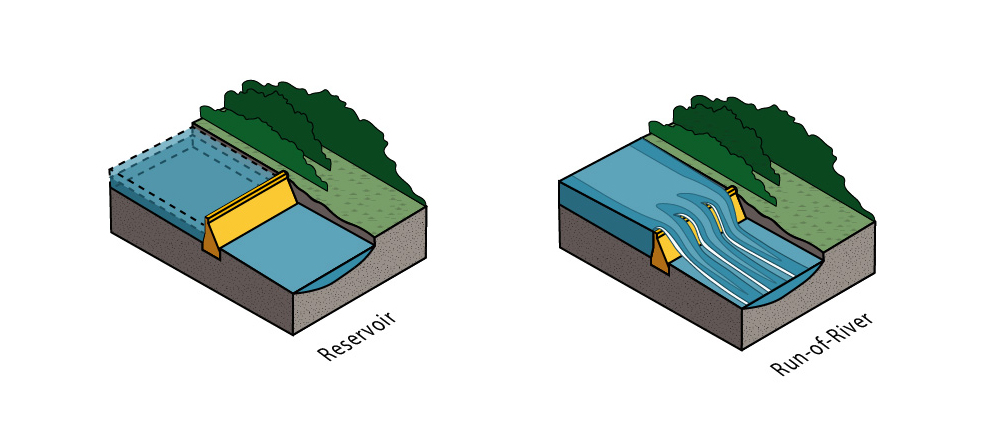
Detention or storage dam and run-of-river dam
Dam Ownership
Unlike the large federally-owned dams in the Western United States, the majority of dams in New England were constructed by private individuals and companies to power mills and many are still privately owned. Within the Narragansett Bay and coastal watersheds, records from state regulatory authorities show that of the dams whose owners are known, 42% of dams are privately owned, 0.5% are federally owned, 37% are owned by states and municipalities. When a property with a dam is sold, the ownership and responsibility for the dam is transferred to the new owner. While some landowners may appreciate having a dam on their property, it is a liability. Dam owners are tasked with the responsibility of the safe operation of the dam and may be liable for the consequences of any accidents or failures of the dam. Furthermore, dam owners must incur the costs of regular maintenance and repairs, as well as the acquisition of any necessary licenses or inspections.
Within Narragansett Bay and the coastal watersheds, there are over 55% of dams whose owner is unknown to the state regulatory authorities. Since many of these dams are over a century old, ownership information may have been lost or forgotten over the years. These “orphan” dams provide a unique challenge for regulating authorities, as many of these dams are in need of repair and the responsible party is not clearly defined.
Even though the majority of dams are privately owned, dams are a public issue. Dams impact the health of rivers, which are a public common resource, and if not properly maintained, they can pose a significant threat to downstream communities. Although the dam owner is ultimately the decision-maker and is responsible for costs associated with the dam, the cost of repairs or removal often far exceeds the financial ability of most private owners – sometimes amounting to hundreds of thousands of dollars. There are no other examples in the United States of such widespread infrastructure being privately owned.
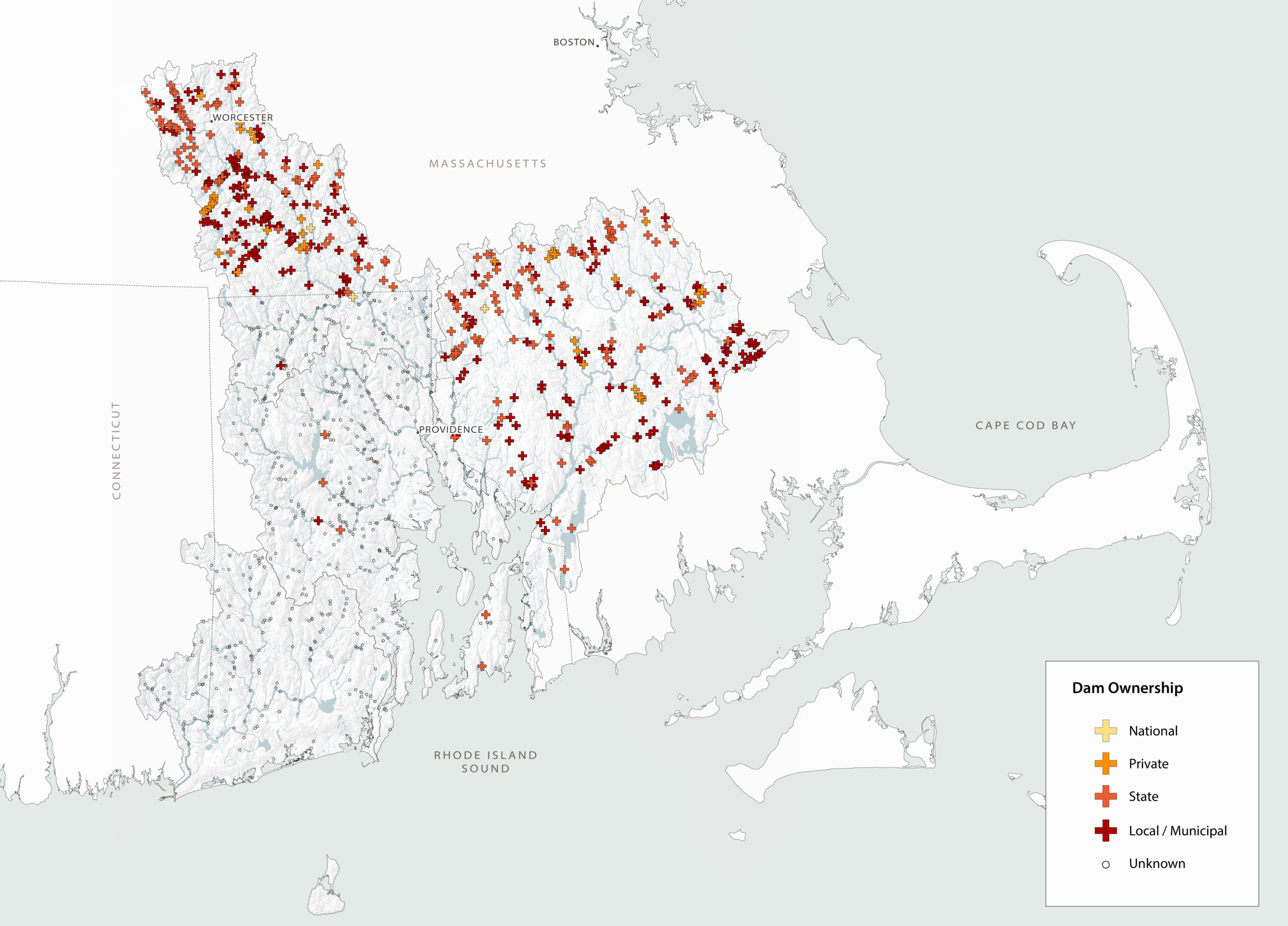
Ownership of dams in the Narragansett Bay and coastal watersheds.
For more information about individual dams, please see the interactive map.
Dam Use
The majority of dams in the Narragansett Bay and coastal watersheds were built for small-scale, localized production of hydropower but are now functionally obsolete. Many dams have been adapted to serve other functions, including recreation, small-scale hydroelectric power generation, and road, rail, or utility river-crossings. Within Narragansett Bay and the coastal watersheds, the majority of the population rely on surface water reservoirs to meet their water consumption needs. The Scituate Reservoir provides drinking water to over 60% of Rhode Islanders and the Assawompset Pond Complex provides water for much of South Eastern Massachusetts, including New Bedford and Taunton. Because they are critical utilities, it is important that these dams and reservoirs are properly maintained to support such functions.
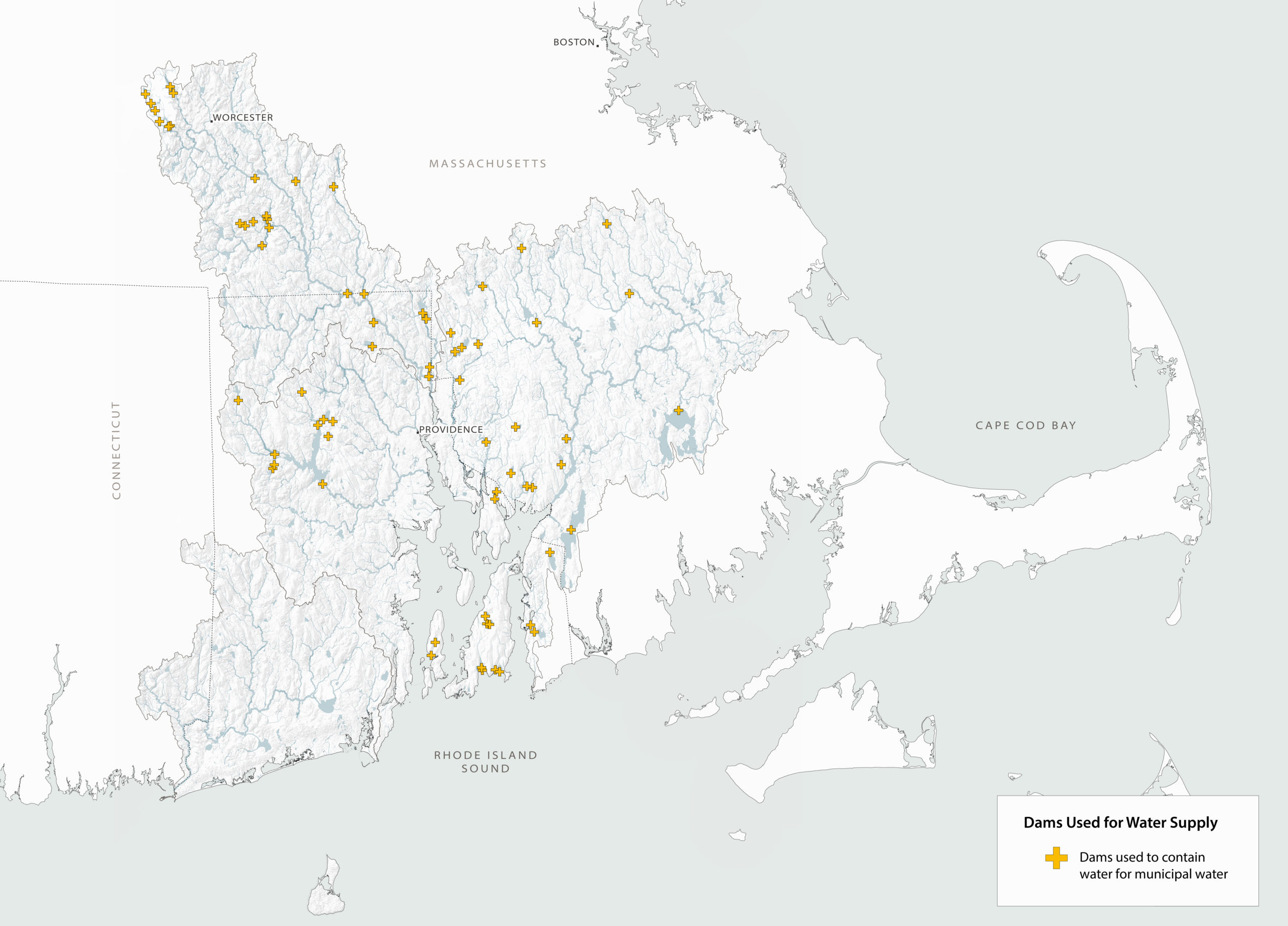
Dams in Narragansett Bay that serve as a water supply.
For more information about individual dams, please see the interactive map.
Within the Narragansett Bay and coastal watersheds, 10 dams currently serve as a source of hydropower (7 in RI and 3 in MA). In Rhode Island, the seven commercial hydropower plants provide less than 0.3 percent of the state’s energy needs. Local electric utilities and the general public are increasingly interested in exploring carbon-free domestic energy sources. Some have advocated that the legacy dam infrastructure in the region could be transformed to provide local distributed energy production. However, given the topography, river flow rate, dam size, and available technology, there are limits to the amount of electricity that dams within the Narragansett Bay and the coastal watershed can generate. For example, a 20 foot tall dam that was proposed on the Pawtuxet river would have provided 0.3 MW of power, while a 70-acre solar power plant proposed for a landfill in East Providence would provide 3.7 MW of power. However, it is possible that new hydropower technology will be more efficient and make distributed micro-hydro (generating 5 kW to 100 kW of electricity) or pico-hydro (less than 5kW) power a possibility, but seasonal low flows will continue to be a challenge and constrain year round outputs.

Dams used for hydroelectric power within Narragansett Bay and coastal watersheds.
For more information about individual dams, please see the interactive map.
The type, ownership, and use of a dam determine how decisions are made about its future. See the Decision Making Tools section to see how ownership and use can affect the decision making process.
Hazard Risk, Climate Change, and Dam Failure
Hazard Risk
The majority of the dams within the Narragansett Bay and coastal watersheds were built over a century ago and are coming to the end of their lifecycle. Many dams have not been properly maintained or repaired over the years and would cause significant damage if they were to breach. Federal and state governments classify dams based on the potential impact of dam failure to downstream communities, infrastructure, and structures. Hazard risk does not consider the structural integrity of the dam — it just focuses on downstream consequences of failure.
There are 3 hazard rankings commonly used by Federal and State agencies:
High Hazard Dams: A dam where failure or misoperation would result in a probable loss of human life to communities downstream of the dam.
Significant Hazard Dams: A dam where failure or misoperation would result in no probable loss of human life but can cause major economic loss, disruption of lifeline facilities or impact other concerns detrimental to the public’s health, safety or welfare.
Low Hazard Dam: A dam where failure or misoperation would result in no probable loss of human life and low economic losses.
Within the Narragansett Bay and coastal watersheds, 55% of the dams do not have hazard data on record. Of the dams that do have hazard rankings within the watersheds, 31% of the dams are classified as high hazard dams, 45% are significant hazard dams, and 23% are low hazard dams.
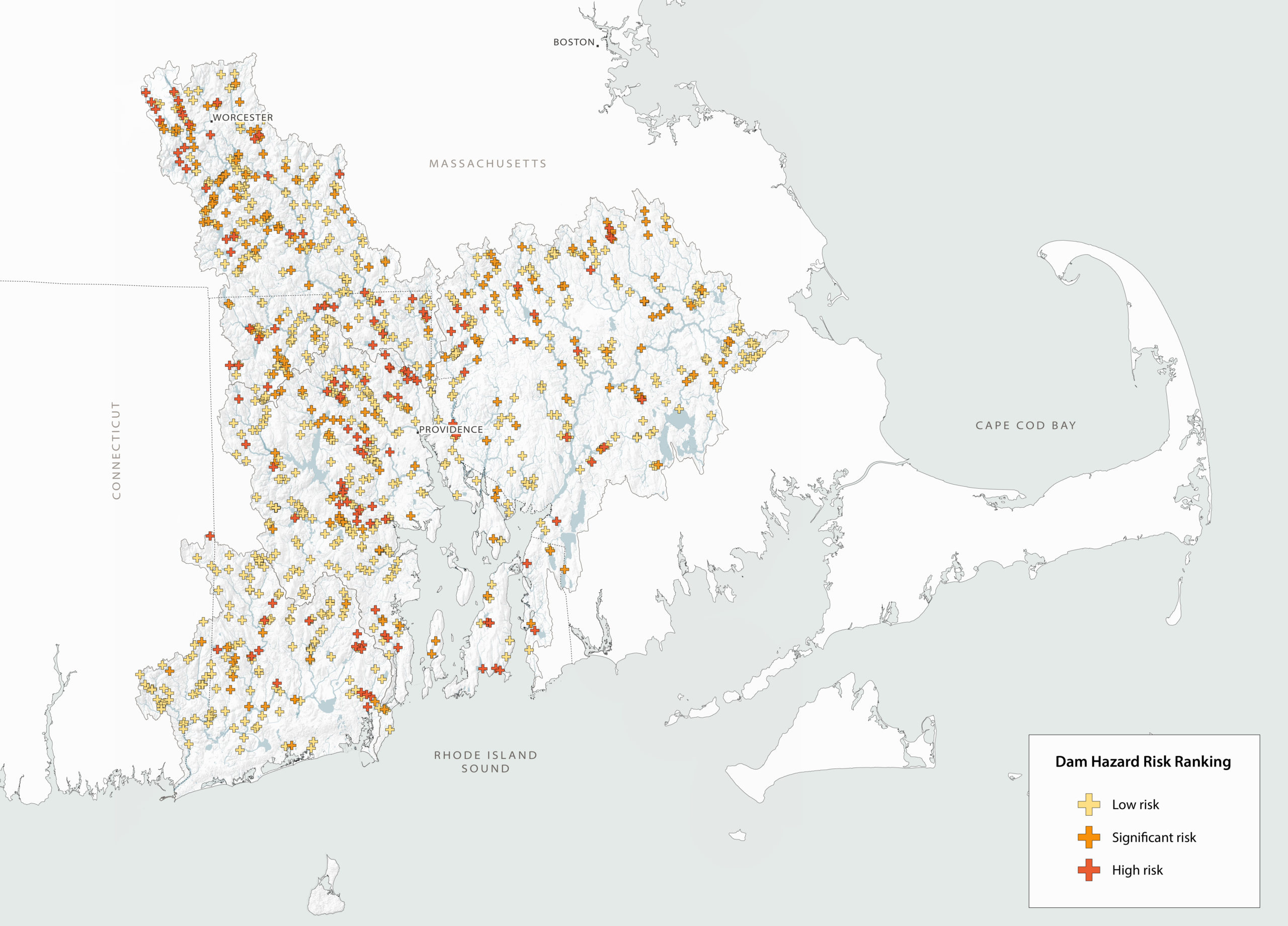
Dams having low, significant, or high hazard risk within Narragansett Bay and coastal watersheds.
For more information about individual dams, please see the interactive map.
In both Massachusetts and Rhode Island, regulated dams include dams classified as significant or high hazard as well as low hazard dams that are six feet or more in height, or that have a storage capacity of fifteen acre-feet (note: an acre-foot is the volume of water of an area approximately 200 ft by 200 ft flooded to a depth of 1 foot). Dams less than 6 feet are unregulated.
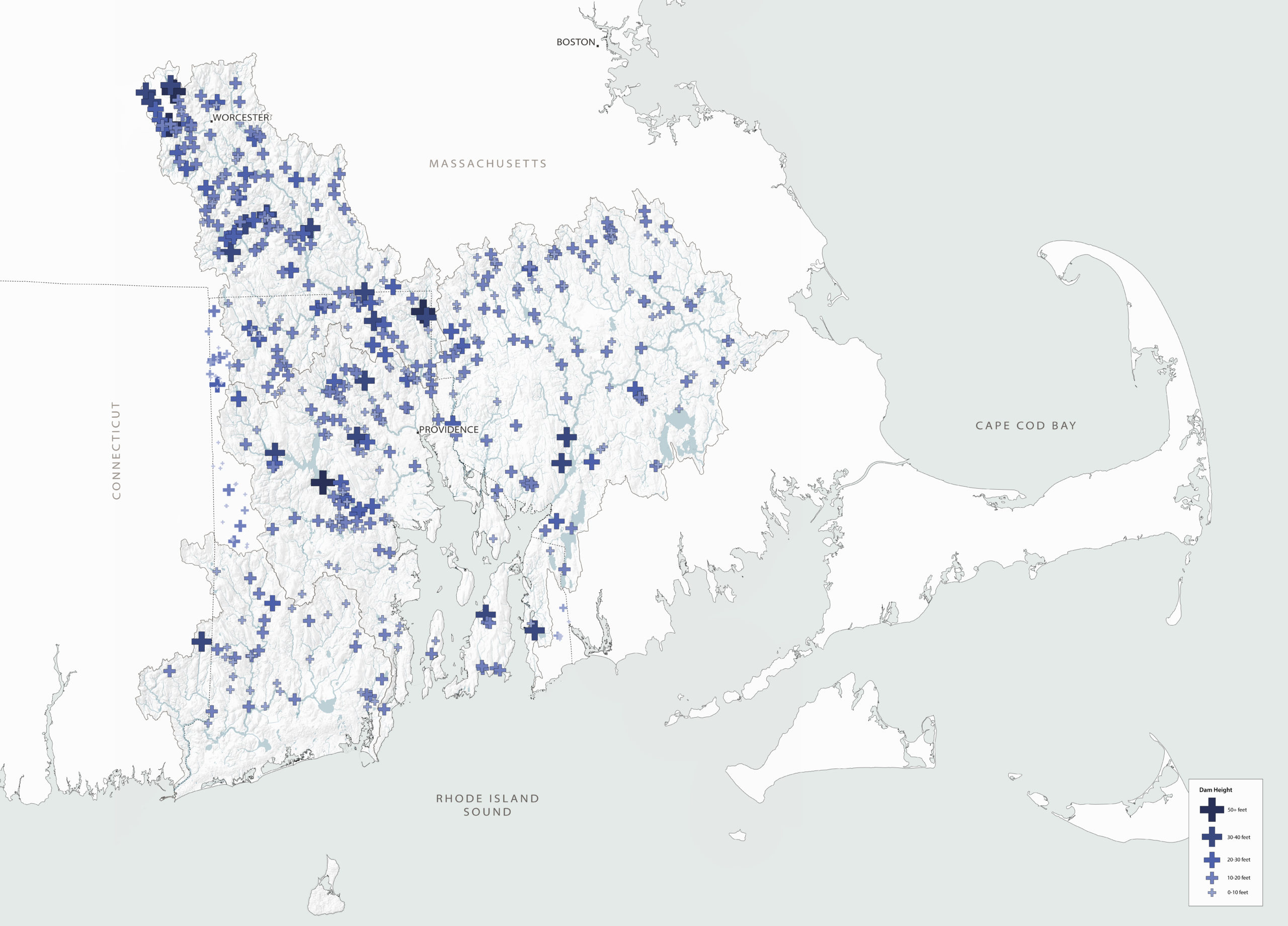
Energy production in the region is limited by dam size and river flow rate.
For more information about individual dams, please see the interactive map.
With the exception of hydropower dams that are regulated by the Federal Energy Regulatory Commission (FERC), there is no national standard for inspecting dams. The Department of Conservation and Recreation Office of Dam Safety regulates dams in Massachusetts and the Rhode Island Department of Environmental Management (RIDEM) monitors regulated dams in Rhode Island.
Within both states, an engineer must inspect and report results every two years for High Hazard Potential dams and every five years for Significant Hazard Potential dams. Within Massachusetts, Low Hazard Potential dams need to be inspected every ten years and in Rhode Island, Low Hazard Dams are required to be inspected every five years.
While the dam hazard ranking communicates the potential impact of dam failure on downstream communities, it does not consider the condition of the dam. When dam inspections are conducted, the condition of the embankment, spillway and low level outlet are ranked good, fair, poor or unsafe. Following the visual inspection, a dam inspection report is prepared, identifying specific deficiencies and, when warranted, recommending corrective measures. In Rhode Island, as of 2019, 54 high and significant hazard dams were identified as unsafe or potentially unsafe and received notice from RIDEM. By the end of 2019, safety issues at 5 of these dams had been addressed. Thirty-one additional high and significant hazard dams in RI were identified as unsafe or potentially unsafe but owners are unknown. Within the portion of the Narragansett Bay Watershed that is in Massachusetts, and that have available hazard data, there are 52 high-hazard dams. At this time, we do not know how many of the high-hazard dams in the Massachusetts portion of the study area are classified as being in poor or unsafe condition.
In addition to inspections, both states expect all dams classified as high and significant hazard to have an Emergency Action Plan (EAP). An EAP is a formal document that identifies potential emergency conditions at a dam and specifies pre-planned actions to be followed during an emergency to minimize loss of life and property damage. The EAP includes an analysis of downstream areas that would be flooded in the event of a dam failure, as well as mechanisms for alerting local emergency agencies and downstream residents if a dam failure is imminent. As of 2019, 31% of high and significant hazard dams in Rhode Island had approved EAP’s on record. At this time, we do not know how many of the high and significant hazard dams in the Massachusetts portion of the study area have approved EAP’s on record.
Climate Change
In addition to the risk associated with the age and lack of maintenance of the dams, there is a growing risk of failure due to extreme weather events. These historic dams were built at a time when severe weather was a rarity, not the norm it is becoming today. In addition, many were built when there were fewer established communities living in the flood zones downstream of dams.
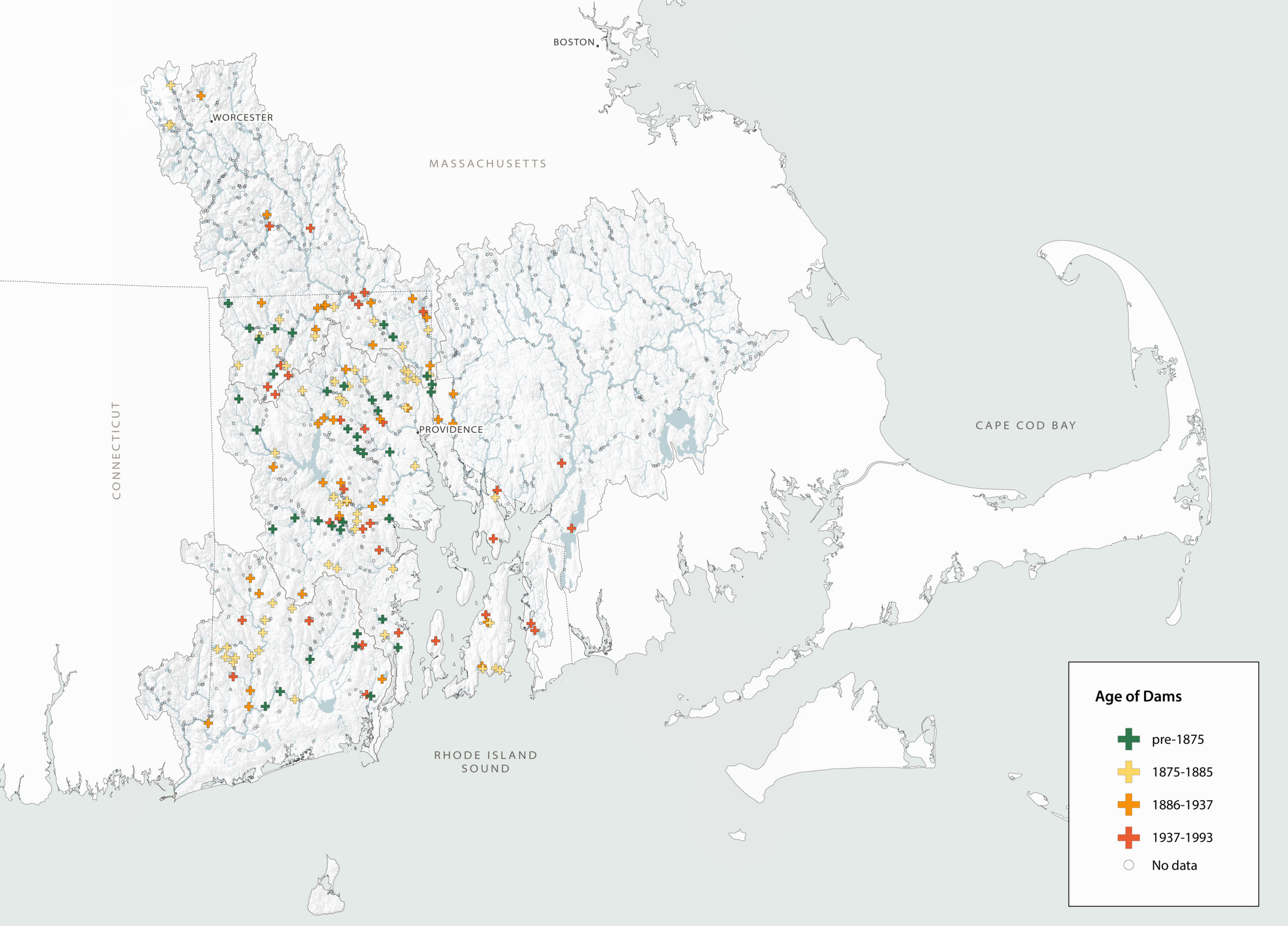
Age of dams within Narragansett Bay and coastal watersheds.
For more information about individual dams, please see the interactive map.
Climate change has altered many aspects of our lives, requiring reconsideration of our long-established national infrastructures, including dams. With the exception of the small number of dams that were constructed specifically for flood control, most dams in the Narragansett Bay and coastal watersheds do not provide flood control benefits. The risk posed by aging dam infrastructure is exacerbated by increasing annual precipitation along with increasing numbers of extreme precipitation events that can lead to flooding upstream of a dam and potential extreme and sudden flooding downstream if a dam fails. For example, the 2010 flood in Rhode Island inundated the state with more than 16.34 inches of rain falling during the month of March — the highest monthly precipitation on record. Many dams could not handle the excess flow and several dams within the region failed. Fortunately, these breaches did not cause loss of life. Similar dam failures around the country, including the failure of the Edenville and Sanford dams in Michigan in 2020, have led to millions of dollars in damages, and thousands of people whose homes were flooded.
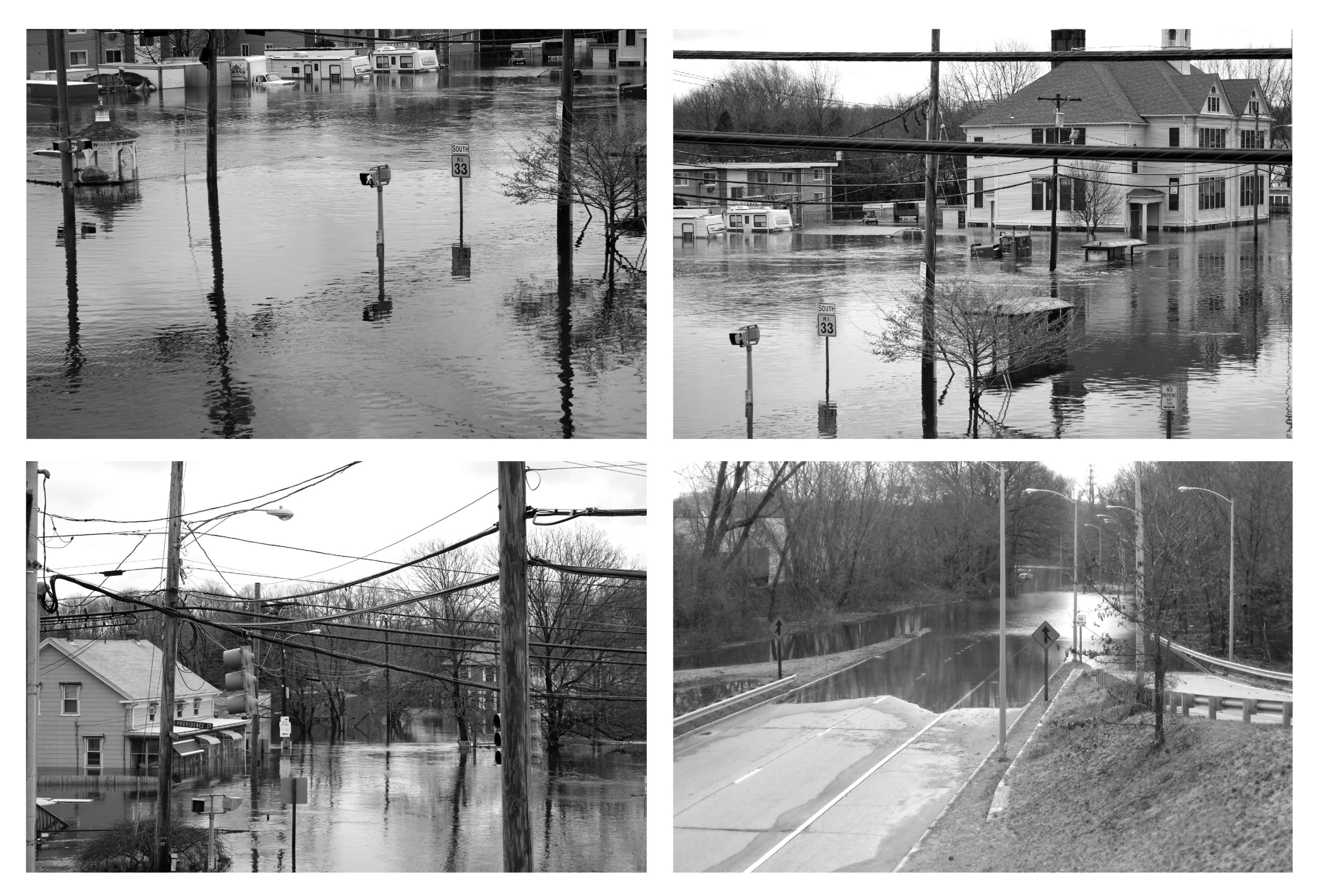
Record Flooding on the Pawtuxet River, March 31, 2010
Photo Source: National Weather Service Northeast River Forecast Center (link to original)
Dam Failure
Dam failure can be catastrophic — leading to loss of life, property and infrastructure. Dam failure is most frequently caused by water flowing overtop of the structure; foundation defects such as slope instability and settlement; and piping, resulting in internal erosion caused by seepage. Other causes may include structural failure of materials, settlement and resulting cracking, and poor maintenance.
Given the age of dams within the region, the increase in large storm events, and the potential risk of a dam failure on downstream communities, there is a need to ensure that local agencies have the resources needed to conduct regular inspections. In addition, while it is important that dams have an Emergency Action Plan on file to know how to react if a dam is failing, it is equally important for States to have adequate funding or other approaches that enable proactive preventative measures to address high and significant hazard dams that are in poor condition.
History
The Narragansett Bay and coastal watersheds are the traditional homelands of the Narragansett, Wampanoag, and Nipmuc nations. Discussions surrounding the history of dams and rivers in New England often focus on the dominant colonial and industrial histories of the region. However, prior to the colonial settlement of New England, Indigenous nations had their own distinct relationship to the region’s rivers. All the tribes of the region relied heavily on rivers for transportation, fishing, and subsistence. Rivers were, and for many continue, to be considered living entities and an important aspect of cultural identity, spiritual livelihoods and lifeways of indigenous communities.
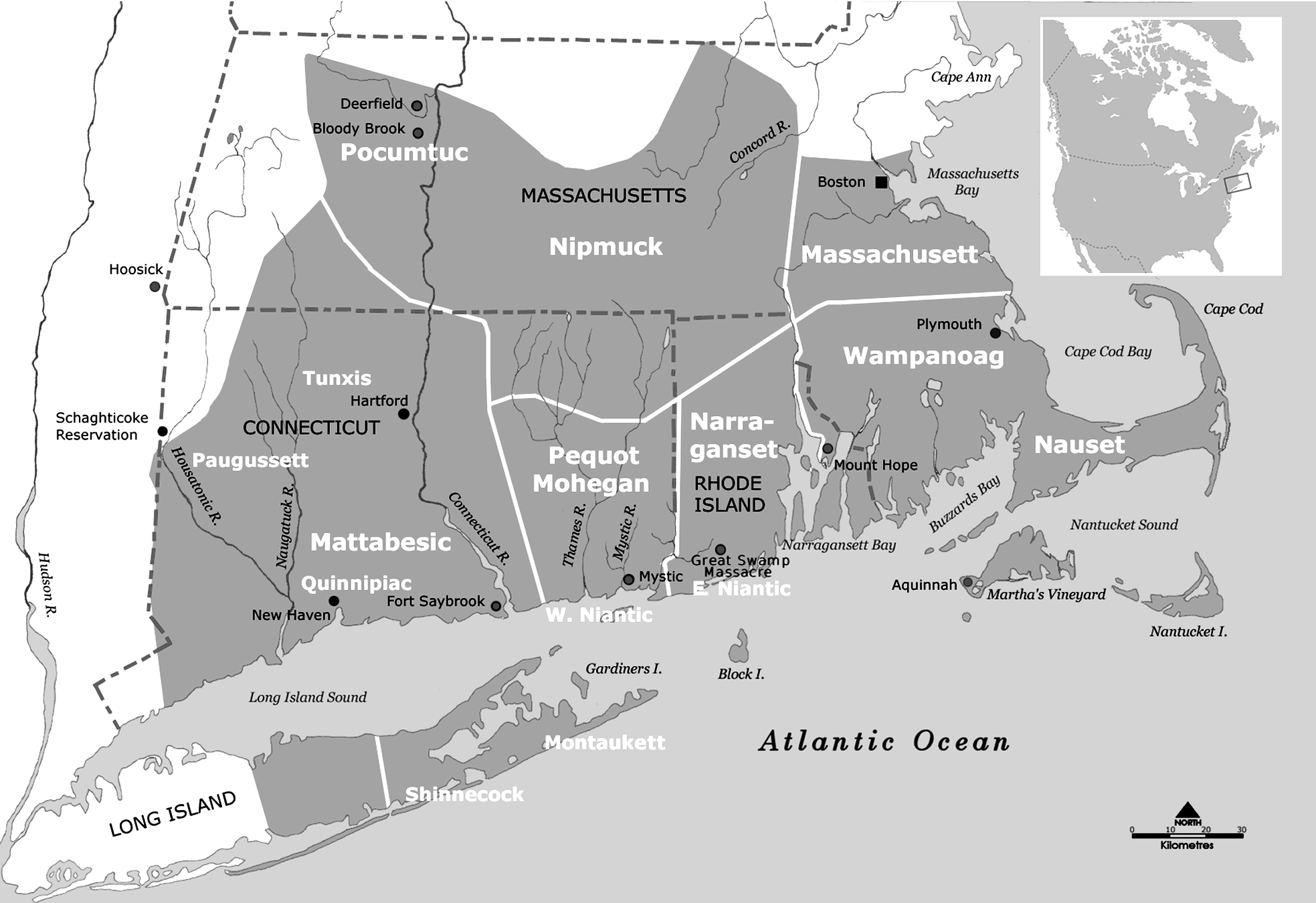
Indigenous Nations of the Narragansett Bay and coastal watersheds
Source: Wikimedia Commons – Image:Wohngebiet_Südneuengland.png, as of 5 July 2006
When European colonists first arrived, they found an abundance of migratory fish throughout New England’s rivers. Indigenous communities had long depended on the migration of these fish which typically coincided with early spring when other food sources were scarce. However, shortly after arrival, the colonists started constructing dams to provide power to mills which blocked these migration routes to the ocean. The impact of dams on fish populations was soon evident to indigenous communities who were cut off from a major food source. This only worsened over time, and by the mid-19th century, many migratory fish, such as shad, eel and river herring, could no longer be found in abundance within the watersheds of RI and the coastal ponds. In addition to the impact of dams on traditional food sources, dams flooded farmland and destroyed gravesites along with other ceremonial and spiritual areas along the rivers.
Rivers are still a crucial part of life for Indigenous communities who live in the region. For some, dams and the diminished migratory fish runs continue to symbolize the injustices of colonization and its impact on indigenous cultures, spiritual connection, and respect between people and the rivers within the region.
Colonial History
Dams played an important role in the colonial and industrial history of the United States. Early Colonial settlement of New England was oriented around the region’s rivers. European colonists brought the knowledge and technology to convert energy from the region’s rocky rivers into power for the early colonial gristmill and sawmills. The construction of Slater Mill Dam on the Blackstone River in 1793 to power the nation’s first textile mill changed the scale and impact of hydropower technology within the region. Slater Mill’s success inspired other local entrepreneurs, prompting the rapid increase of hydro-powered mill construction and leading to widespread changes to the New England landscape. However, the advent of steam power during the Industrial Revolution allowed factories to reduce their reliance on rivers and hydropower. This led to the shift of production out of New England, leaving dams as post-industrial relics throughout the landscape.
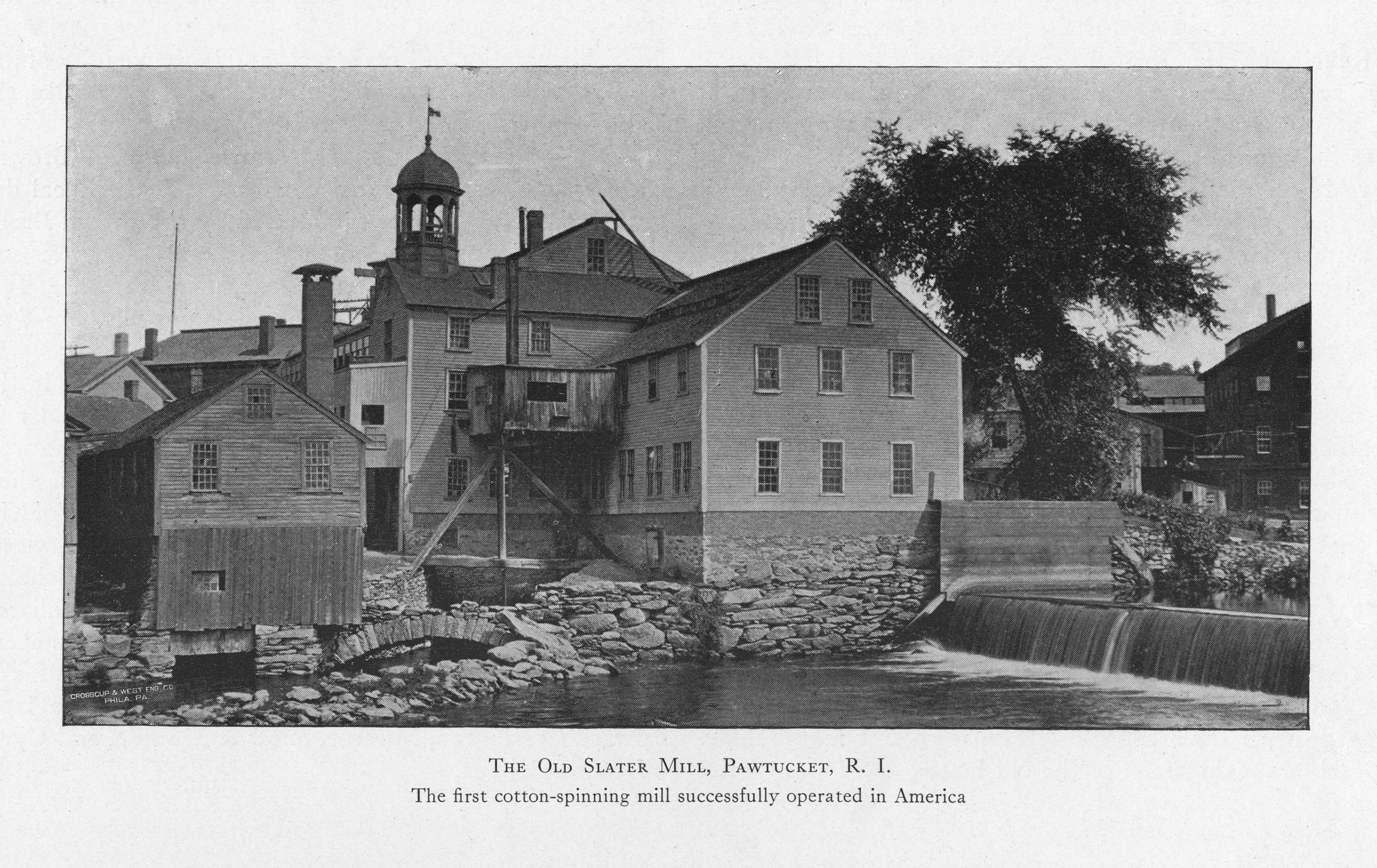 Slater Mill dam; Source: Providence Public Library
Slater Mill dam; Source: Providence Public Library
As thousands of dams reach the end of their life cycles, communities around the country must make decisions about the future of their aging dam infrastructure. When making a decision about a dam, there is often the need to balance ecological restoration and public safety with the desire to preserve local history and the unique cultural landscapes of New England. Some dams, including Slater Mill Dam among others, are officially listed on the National Register of Historic Places. This federal register documents properties that are “significant in American history and worthy of preservation.” Section 106 of the National Historic Preservation Act (NHPA) requires federal agencies to follow a review and consultation process to consider the effects of their undertakings on historic properties. As part of this process, a range of alternatives are explored that can help avoid, minimize and mitigate the impact to a historic property.
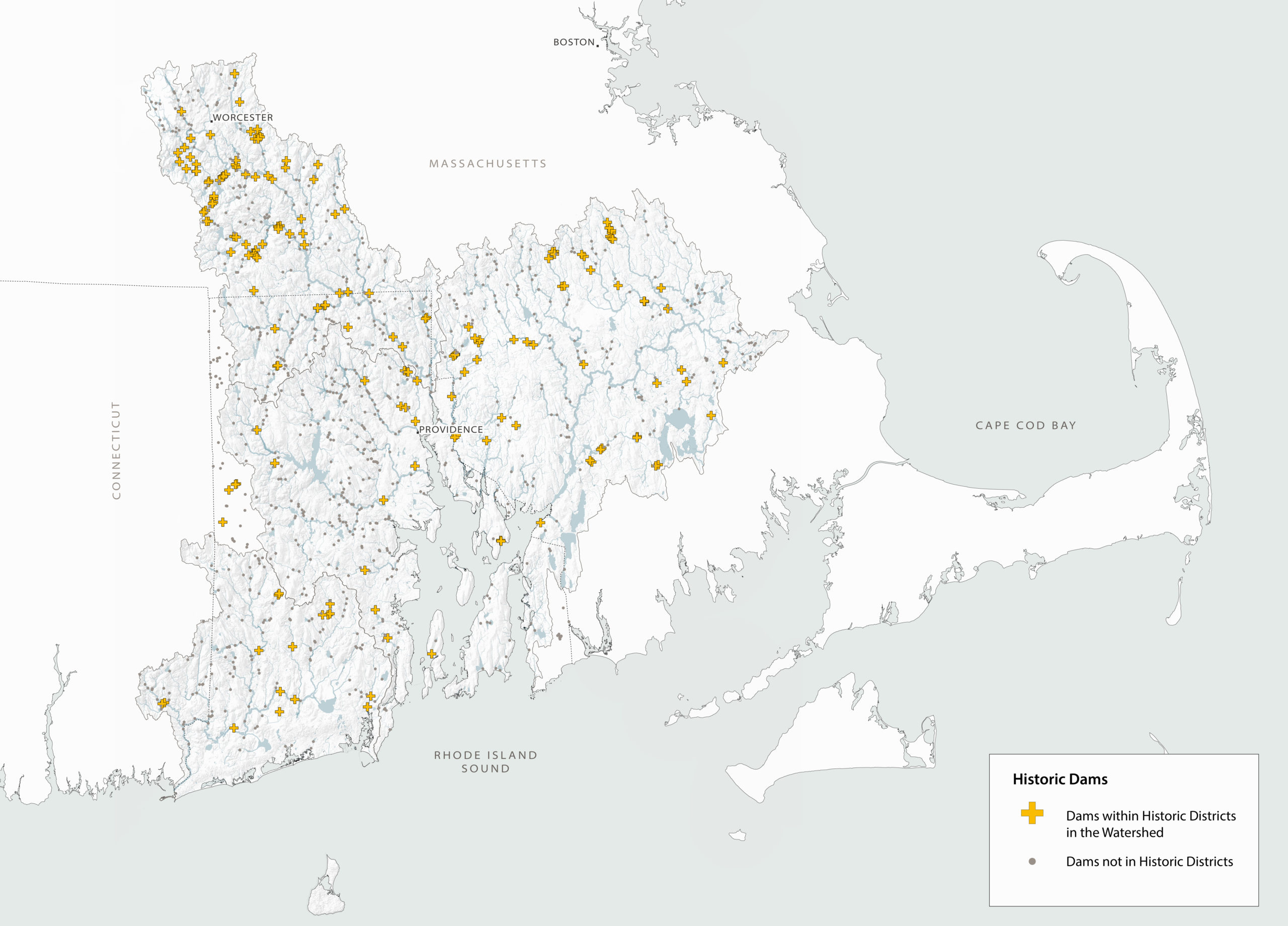
Dams within Historic Districts in the Watershed.
For more information about individual dams, please see the interactive map.
Some dams are not listed on the National Register of Historical Places but hold significance for local communities as cultural landscapes and are part of the local sense of place. According to the World Heritage Convention, cultural landscapes represent the “combined works of nature and of man. They are illustrative of the evolution of human society and settlement over time.” Dams, associated mill ponds, and old mill structures make up the unique cultural landscape of New England that tell the story of how landscapes and colonial settlement are intricately connected in this region.
Photo across Forge Pond on the Westport River with historic mill in the background. Dams and their associated reservoirs and mills are part of the cultural landscapes of New England. Photo by Emily Vogler
In some cases, the historic significance of a dam may lead to a historic dam structure being repaired and maintained. However, for other sites, there may be an opportunity to use design to mark the location of the dam and recognize the multiple histories of the dam and river without preserving the physical dam structure. Refer to the “Scenarios” page to explore some of the alternatives that can be used to mark, interpret, and adapt historic dam structures to help maintain the sense of place even if the dam structure is removed.
ADDITIONAL INFORMATION:
For additional information see Dam Removal and Historic Preservation: Reconciling Duling Objectives.
Sense of Place + Recreation
Sense of place indicates our emotional connection or attachment to specific places or landscapes. Sense of place often develops over time through personal experience and encompasses a variety of qualities. Social, cultural, ecological, aesthetic, or historical associations all have the ability to create a special relationship between people and their environment.
Because it largely develops from experience and perception, sense of place differs for each individual. While one person might have positive memories associated with a specific location, another might experience this same place negatively. Regardless of perception, attachment to a place plays an important part in one’s mental health. It is not unusual for this type of emotional connection to become intertwined with one’s own personal and cultural identity.

Visibility of dams within Narragansett Bay and coastal watersheds.
Community sentiment around a dam may vary based on the location, structure, history, and the use of the dam and reservoir. A dam may have been the foundation of a community, used to provide power for a mill by one generation, and a tourist attraction for the next – becoming an important part of the community identity, sense of place, and pride. In some cases, a community’s attachment may be to the reservoir rather than to the dam itself. It may be a cherished community swimming hole or a place where generations have grown up fishing. In some cases, the aesthetics of the dam are valued by the community — the view of the waterfall, the sound of falling water, a visual landmark within the forest. And for others, the dam may represent the colonization of the river and the appropriation of the land from Indigenous communities.

Aesthetics of a dam, Horseshoe Falls.
Photo by Emily Vogler
Depending on whether a community’s attachment is to the dam, the reservoir, or the free-flowing river, various future scenarios may be considered. For example, a nature-like fishway can preserve a reservoir while significantly improving fish passage, however the dam structure will no longer be visible. If space exists around the dam, a bypass channel can preserve the view of the dam while also significantly improving fish passage and habitat connectivity. In addition, there may be ways to use design to maintain a sense of place and the aesthetics of the dam even if the dam is removed. See the “Scenarios” page to explore some of these alternatives.
Since all dams and all communities are unique, it is important for local communities to discuss what is significant to them. The Decision Support Tools can provide guidance on helping communities discuss their local dam to explore what aspects of the dam and surrounding landscape are important to them.
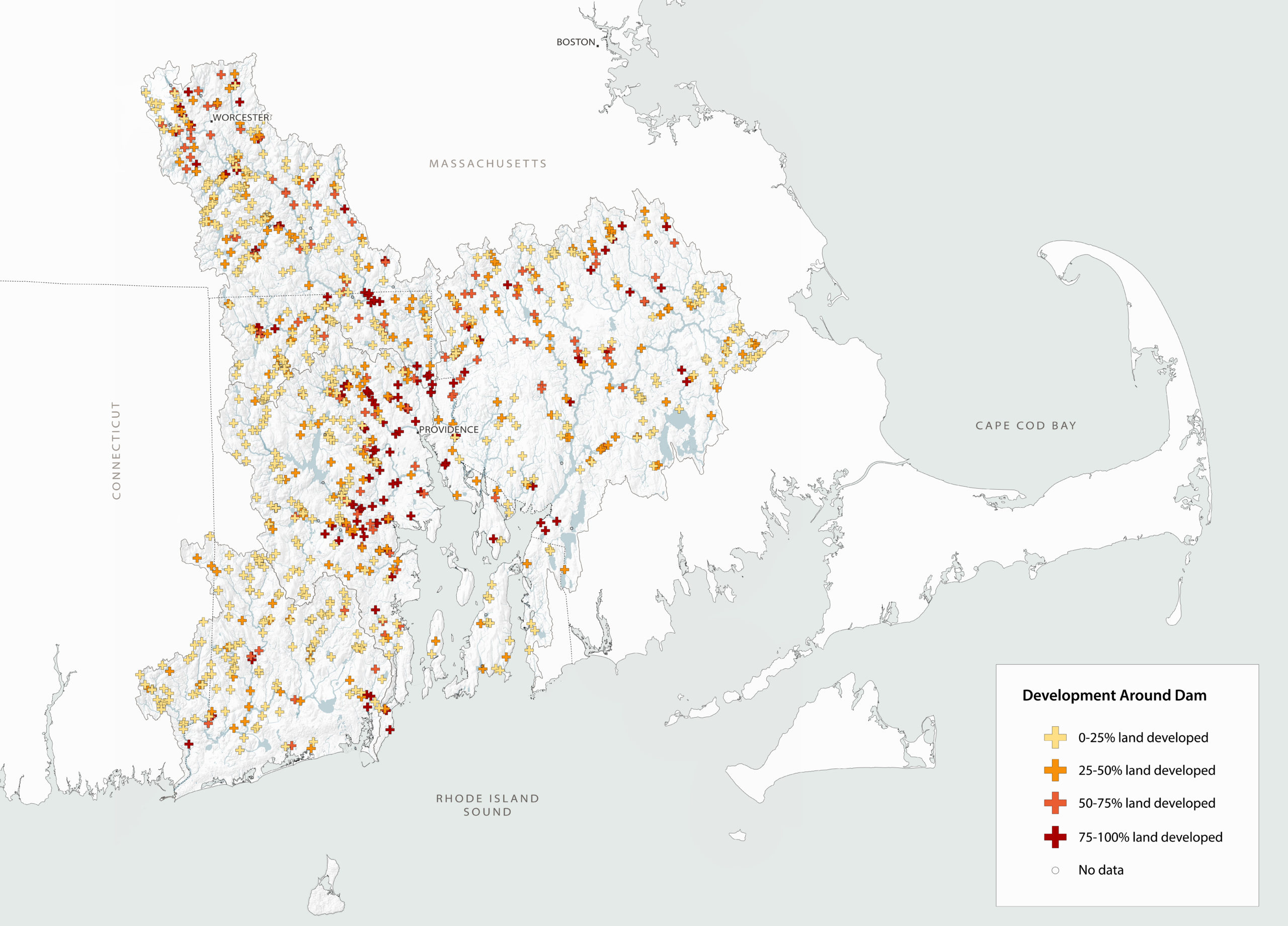
A dam in the middle of a forest may have a different level of attachment than one in the middle of town.
For more information about individual dams, please see the interactive map.
Recreation
One of the primary ways that people currently interact and develop a connection to the region’s rivers is through recreation. Within the Narragansett Bay and coastal watersheds, waterways provide an important opportunity for recreation. In addition to the 256 miles of coastline in Narragansett Bay, there are over 3,000 miles of rivers and streams in the watershed that provide freshwater boating, swimming and fishing opportunities.
Flowing River Recreation
Rivers within the region are a popular recreational destination for kayaks and canoes. Whether day trips or overnight trips, smooth water or rapids, paddlers flock to rivers in the warm months of the year. However, the high number of dams in the watershed create an obstacle and hazard for paddlers traveling downstream along a river. Paddlers have to be knowledgeable about the location of dams and the location of portages (locations where boats need to be carried around a dam). In some places, the portage includes challenging and lengthy traverses across roads and up steep embankments. There is also a significant risk that paddlers unaware of a dam’s location can go over the dam, capsize and potentially drown. The presence and frequency of dams on rivers can prevent paddlers from feeling safe exploring the region’s rivers. In addition to paddling, some of the region’s free flowing rivers are commonly used for fly-fishing.

Water access points within Narragansett Bay and coastal watersheds. A dam in the middle of a forest may have a different level of attachment than one in the middle of town.
For more information about individual dams, please see the interactive map.
Reservoir Recreation
Flat water behind a dam provides a different set of recreational opportunities. Reservoirs or impounded rivers are often used by communities for boating, swimming and fishing. In addition to canoes and kayaks, reservoirs are sometimes accessible to motorized boats. Out of the 801 reservoirs in the watershed, 68 (or 8.5%) are stocked with fresh water fish. Additionally, the flat water of reservoirs make them popular swimming places for people of all ages. The recreational opportunities on a reservoir will vary based on size and access. Some have boat ramps and docks while others have restricted access due to them being for water supply.
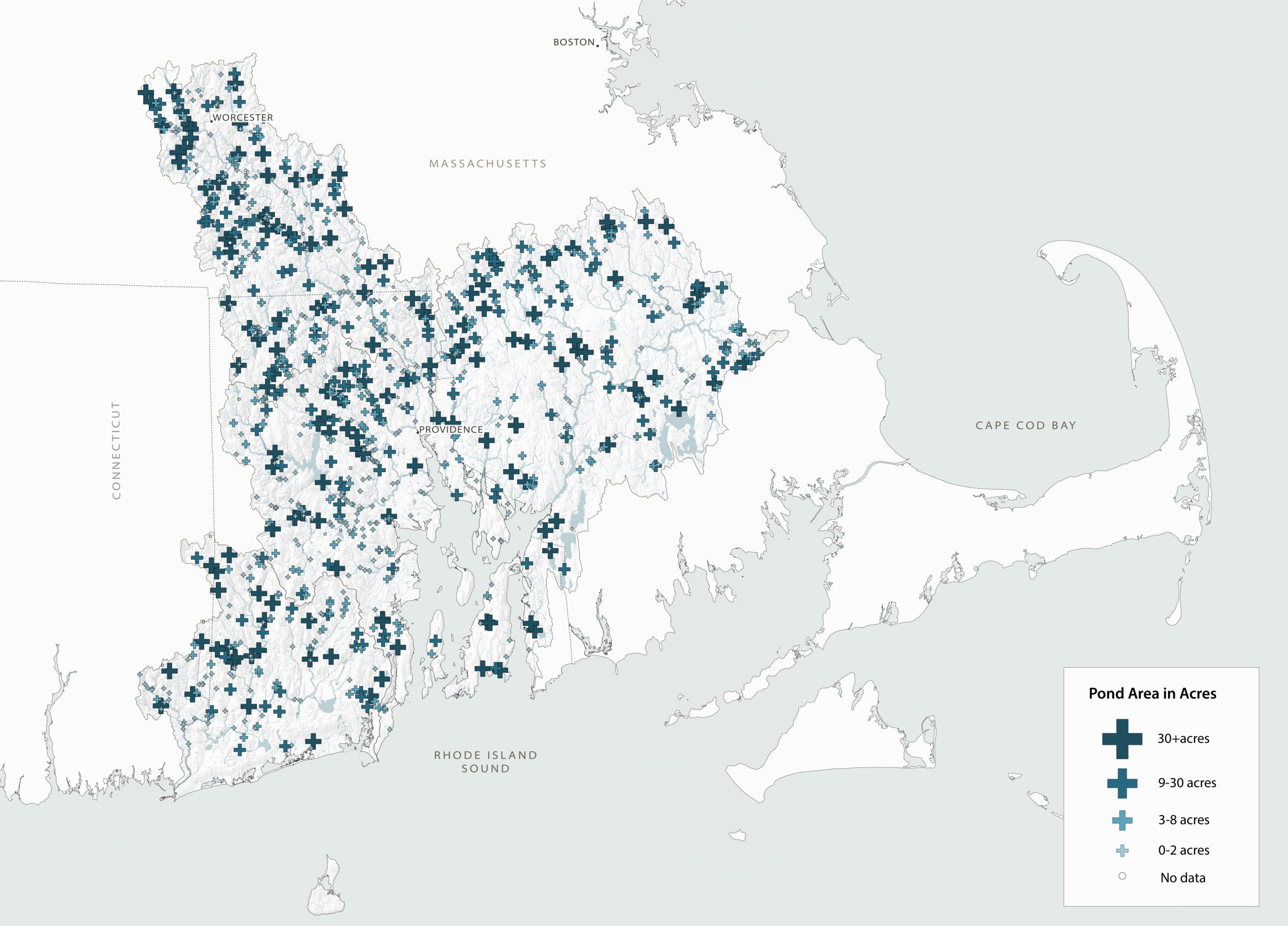
Size of reservoirs within Narragansett Bay and coastal watersheds. A dam in the middle of a forest may have a different level of attachment than one in the middle of town.
For more information about individual dams, please see the interactive map.

Reservoirs that are stocked with fish within Narragansett Bay and coastal watersheds. A dam in the middle of a forest may have a different level of attachment than one in the middle of town.
For more information about individual dams, please see the interactive map.
When making a decision about the future of a dam, there is a trade-off between prioritizing flowing river recreation vs recreation on flat water of a reservoir. See the “Scenarios Page” to explore some of the alternatives that can be used to preserve a reservoir while improving habitat connectivity and fish passage.
Fish Passage + Ecosystem Impacts
River systems are dramatically altered by the construction of a dam, which often has a lasting impact on interspecies relationships and overall habitat connectivity. More than just flowing water, rivers transport fish, sediment, and aquatic organisms between the headwaters (the smallest parts of river and stream networks) to the mouth (where the rivers discharge into coastal waters), sustaining healthy ecosystems along the way. Dams disrupt the system by acting as barriers that disconnect upstream and downstream river lengths, effectively weakening multiple ecosystems.
River Flow and Ecosystem Dynamics
Before European settlement, beaver dams and ponds were common in the smaller streams of the Narragansett Bay Watershed. However, these beaver dams did not generate the extent of changes associated with current dams in the watershed; beaver dams are relatively small, highly porous (leaky) and often seasonal or temporary. In contrast to beaver dams, dams constructed for industry and power along the rivers in the Narragansett Bay and coastal watersheds were large, permanent, and impervious, creating a large-scale shift in the flow and ecology of rivers. Dams effectively transform portions of a river ecosystem into a lake ecosystem (or reservoir). While different aquatic and terrestrial species thrive in these distinct habitats, both rivers and reservoirs can provide critical wetland habitat. These wetlands may serve as travel corridors; nesting, feeding, resting, nursery and brood-rearing sites; drinking water sources and escape cover; and provide seasonal breeding, migration and overwintering habitat for wildlife.
Free-flowing reaches of rivers and streams transport wood, rocks, and other natural debris downstream where they accumulate to create characteristic riffles (shallow rocky areas), pools, and meanders. These habitat features act as shelter for prey species and help to support coldwater fish species such as Brook Trout, Fallfish, Blacknose Dace, and Longnose Dace. There is also a unique macroinvertebrate fauna of mayflies, stoneflies, caddisflies, midges, craneflies, blackflies, dragonflies and damselflies, crayfish, and mollusks. In Rhode Island, due to habitat loss, dams, water pollution, and climate change, Eastern brook trout are listed as a Species of Greatest Conservation Need.
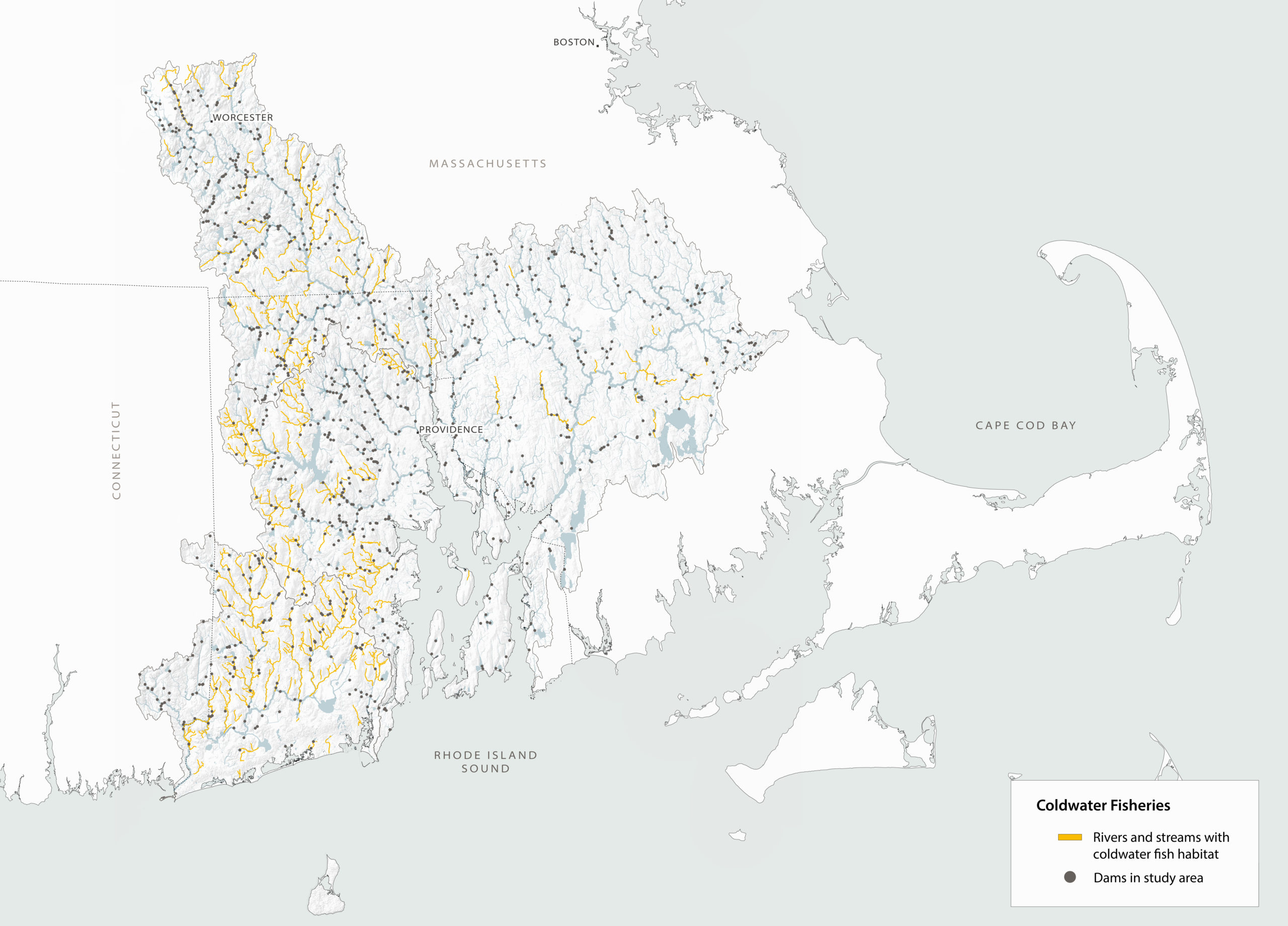
Coldwater streams supporting fish habitat. A dam in the middle of a forest may have a different level of attachment than one in the middle of town.
For more information about individual dams, please see the interactive map.

Diagrammatic section of free-flowing river
When dams are constructed, the river habitat above the dam is transformed into a lake habitat that supports warm-water species such as large and smallmouth bass, bluegill, and chain pickerel. Within these reservoirs, wetlands often emerge along the shoreline or in shallow areas, providing spawning and nursery habitat for a number of fish species. In addition, turtles, amphibians, and fish feed on the abundant invertebrate species that are found among aquatic plants. In some cases, rare and endangered species can be found in the novel lake ecosystems created by the reservoir. The presence of these species requires careful consideration of the possible dam scenarios to ensure that the selected alternative does not have a negative impact on the endangered species.

The river below the dam no longer receives input of wood, rocks, debris and sediment to create critical habitat features, and begins to behave more like a chute with reduced habitat diversity. Dams may also reduce genetic diversity within an ecosystem by separating resident fish populations and wildlife from their natural habitat and range. When free-flowing systems are dammed, there may be an influx of non-native species, which shifts predator-prey dynamics. While dams often have a negative impact on habitat connectivity and species diversity, there are some cases in which dams have prevented the spread of invasive species or disease from one fish population to another by blocking passage.
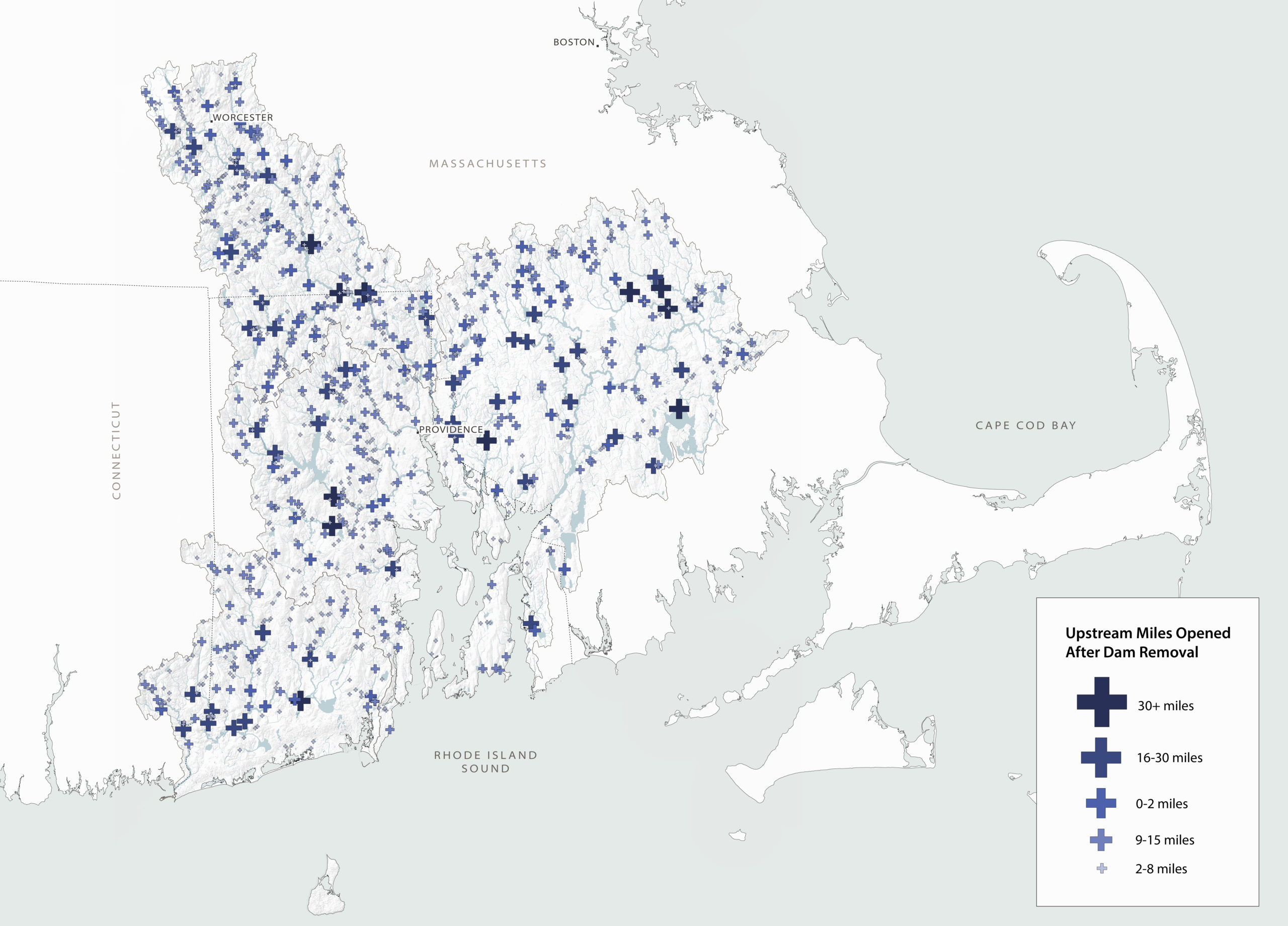
Miles of upstream river and stream opened to passage after dam removal.A dam in the middle of a forest may have a different level of attachment than one in the middle of town.
For more information about individual dams, please see the interactive map.
Migratory Fish Passage
Dams disrupt the migration and spawning of fish, which travel through waterways at different stages in their lives. Anadromous fish such as salmon, American shad, and river herring live in the ocean and travel back to fresh water every spring to spawn (reproduce). Using the earth’s magnetic field as a guide, they return to the exact location where they were born. Once they find their specific river, they use odor to locate their home stream. If unable to reach this stream, rather than spawn in a new location, some will continue searching until they have depleted all of their energy and die in the process. American eel are catadromous–they spawn in the Atlantic ocean and the young migrate into the river networks to feed and mature–often remaining for 5 to 40 years in freshwater ecosystems before returning to the ocean to reproduce. The migration of fish and eels is not only critical for the survival of the species, but it also contributes to the whole ecosystem as the fish recycle nutrients along the way.
Historically, the river systems of Narragansett Bay and the coastal ponds, which drain into the Narragansett Bay and Block Island Sound, supported healthy migration of River Herring, Atlantic Salmon, shad and American eels, allowing them to feed and reproduce. However, after the proliferation of dams, these species declined dramatically. Rhode Island’s once lucrative Atlantic salmon fishery collapsed in 1870, and the river herring fishery was significantly depleted by 1930.
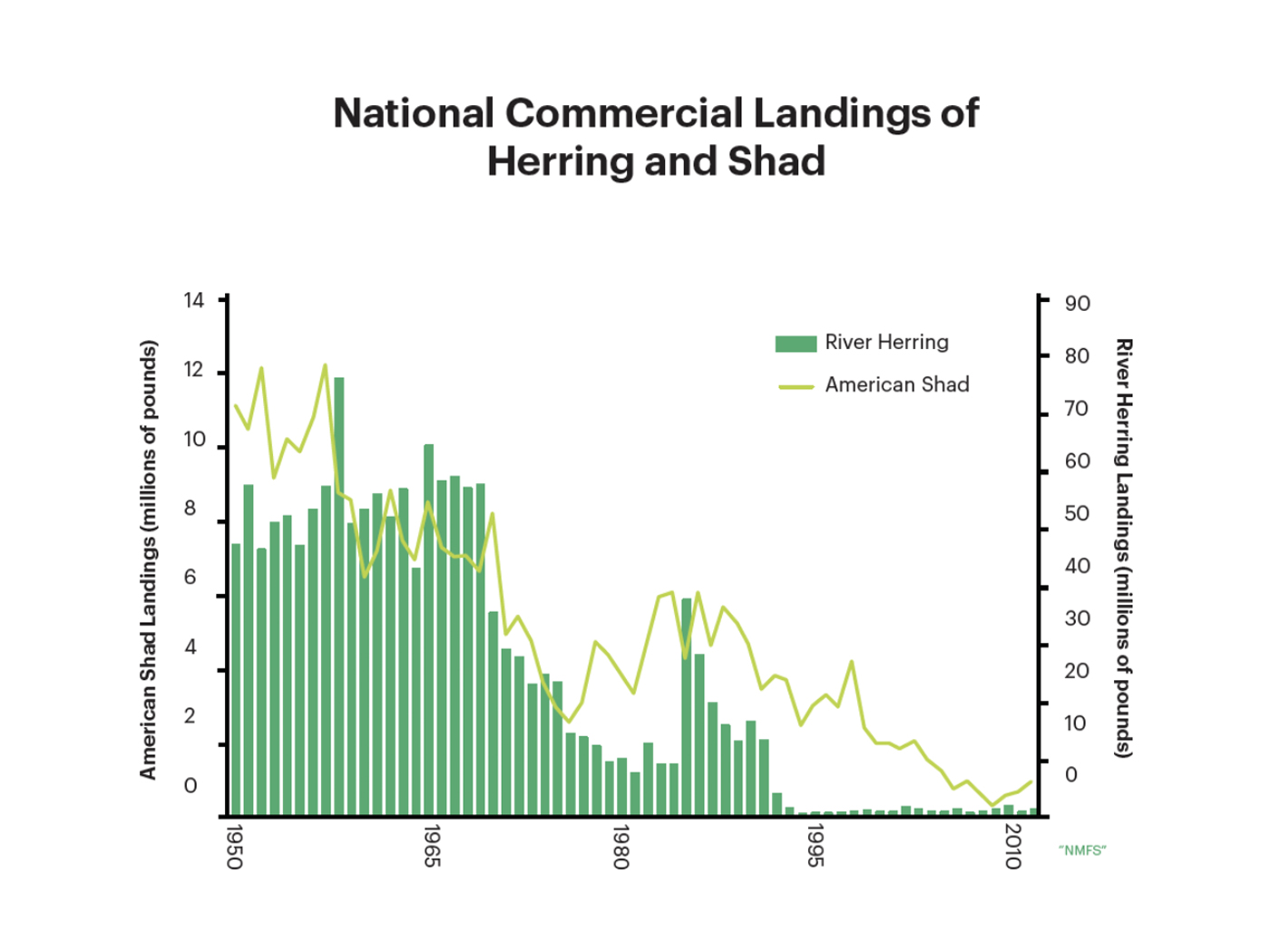
National commercial landings of herring and shad
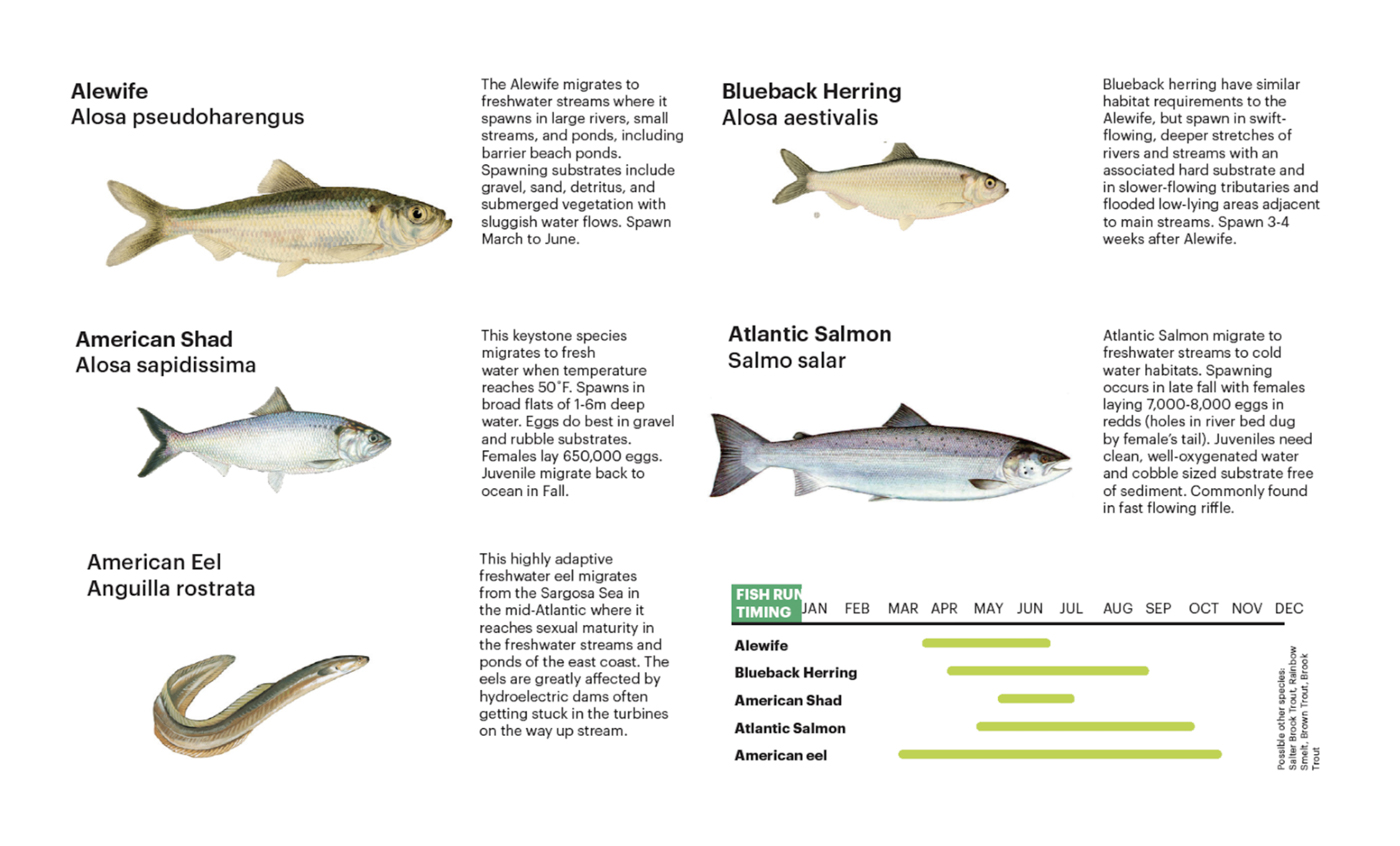
Anadromous fish found within the Narragansett Bay
Due to the importance of migrating fish species to the coastal rivers of Narragansett Bay, when trying to understand the impact of a dam, it is important to consider the locations of the dam within the watershed. Head of tide dams are the first dams on a river system. If these dams do not allow for fish passage, the whole river system is impassable to migratory fish, greatly diminishing their spawning habitat and ability to reproduce. Dams located on the main stem of river systems are particularly disruptive to fish migration since they cut off huge areas of the upstream watershed. When fish are stopped or delayed by a dam, even if the dam allows for some fish passage, they become easy prey and may experience significant population decline while predator species flourish.
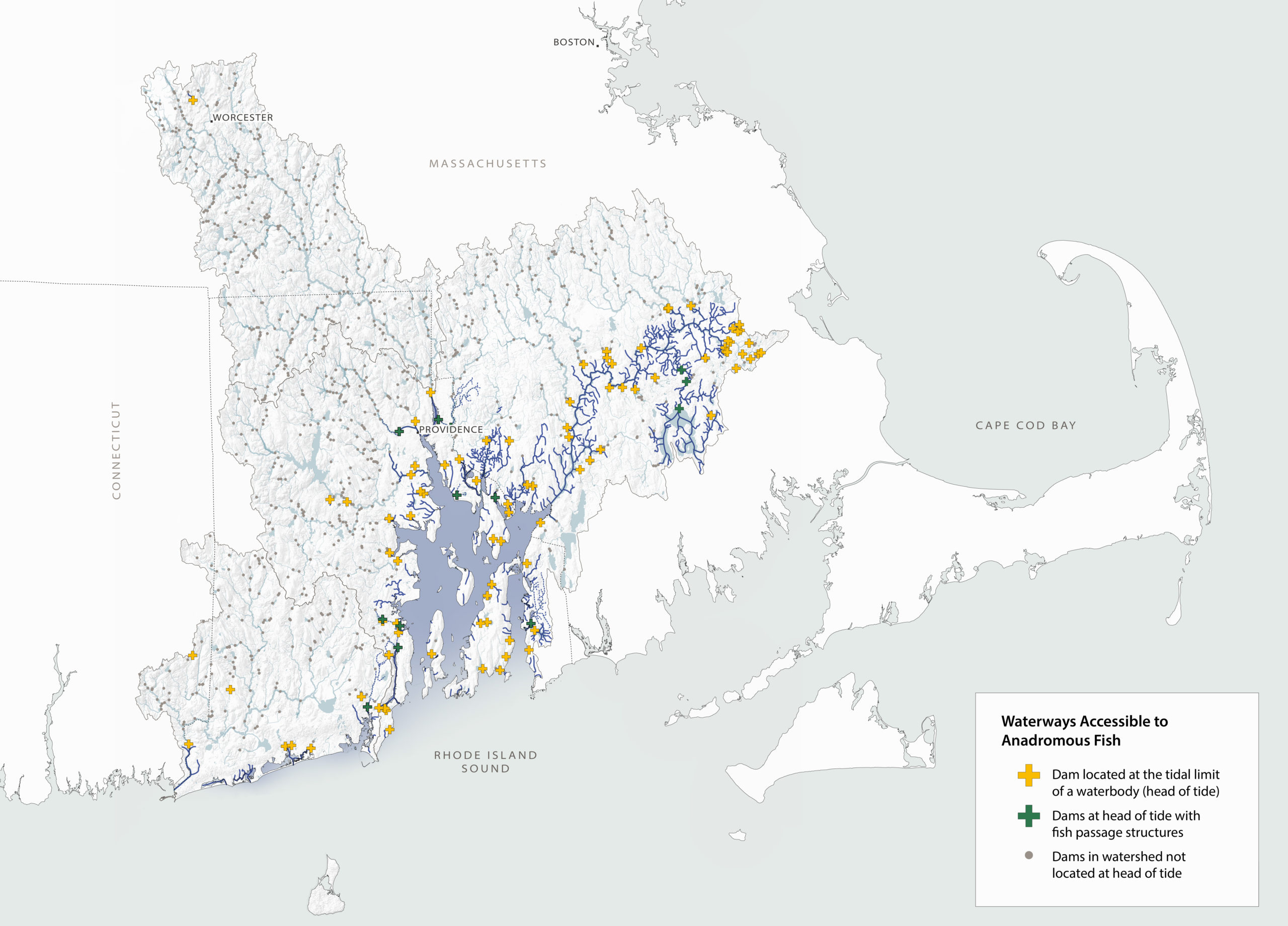
Anadromous fish passage at head of tide dams (dams located at the farthest point upstream where a river is affected by tidal fluctuations) within Narragansett Bay and coastal watersheds. A dam in the middle of a forest may have a different level of attachment than one in the middle of town.
For more information about individual dams, please see the interactive map.
In cases where dams have been removed along rivers in New England, some species of migratory fish quickly return, sometimes to rivers where they have not been seen for over 200 years. In areas where dam removal is not possible, alternative fishways may be an option to improve fish passage. See the “Scenarios” page for more information about the various dam alternatives to improve fish passage. A full ecological assessment is needed as part of any dam related project to evaluate the current wildlife and wetland habitats and to understand how they will be affected by the scenarios being considered.
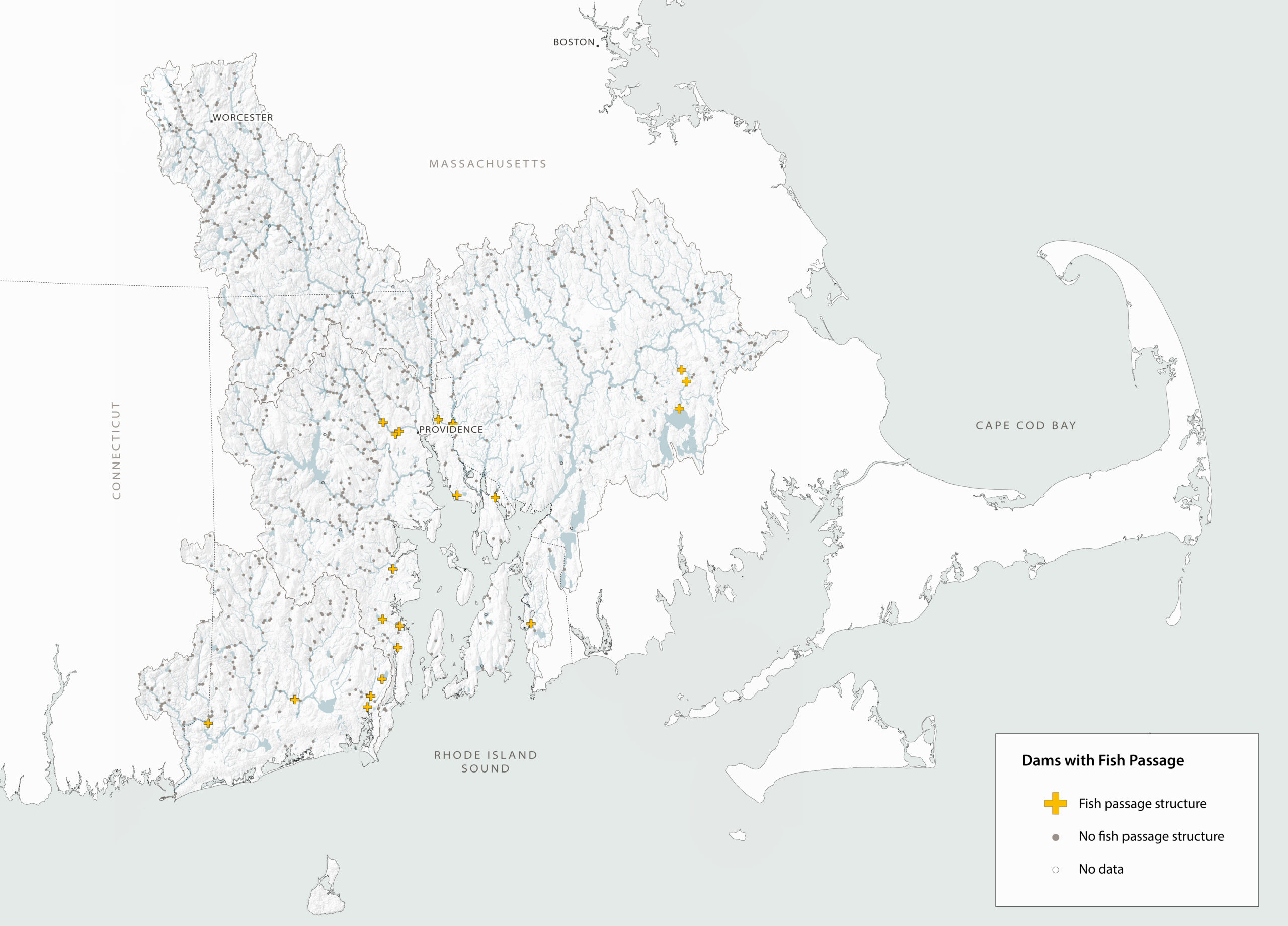
Dams with fish passage modifications. A dam in the middle of a forest may have a different level of attachment than one in the middle of town.
For more information about individual dams, please see the interactive map.
Water Quality + Sediment
Dams alter the flow of a river, which can change many aspects of water quality. Dams can increase river temperatures by creating stagnant reservoirs with large surface areas that absorb the sunlight. Surface conditions may become unsuitable for many cold-water fish species that once thrived in rivers. Warmer waters experience accelerated evaporation and a lower capacity to hold oxygen that can negatively impact fish and aquatic life. Dissolved oxygen levels are also impacted when a dam changes the flow regime from a fast-moving river that gathers oxygen as the water flows downstream to a dammed reservoir with still water. In large, deep reservoirs release of cold bottom waters can support a cold water fishery (trout or herring) for several miles downstream of the dam.
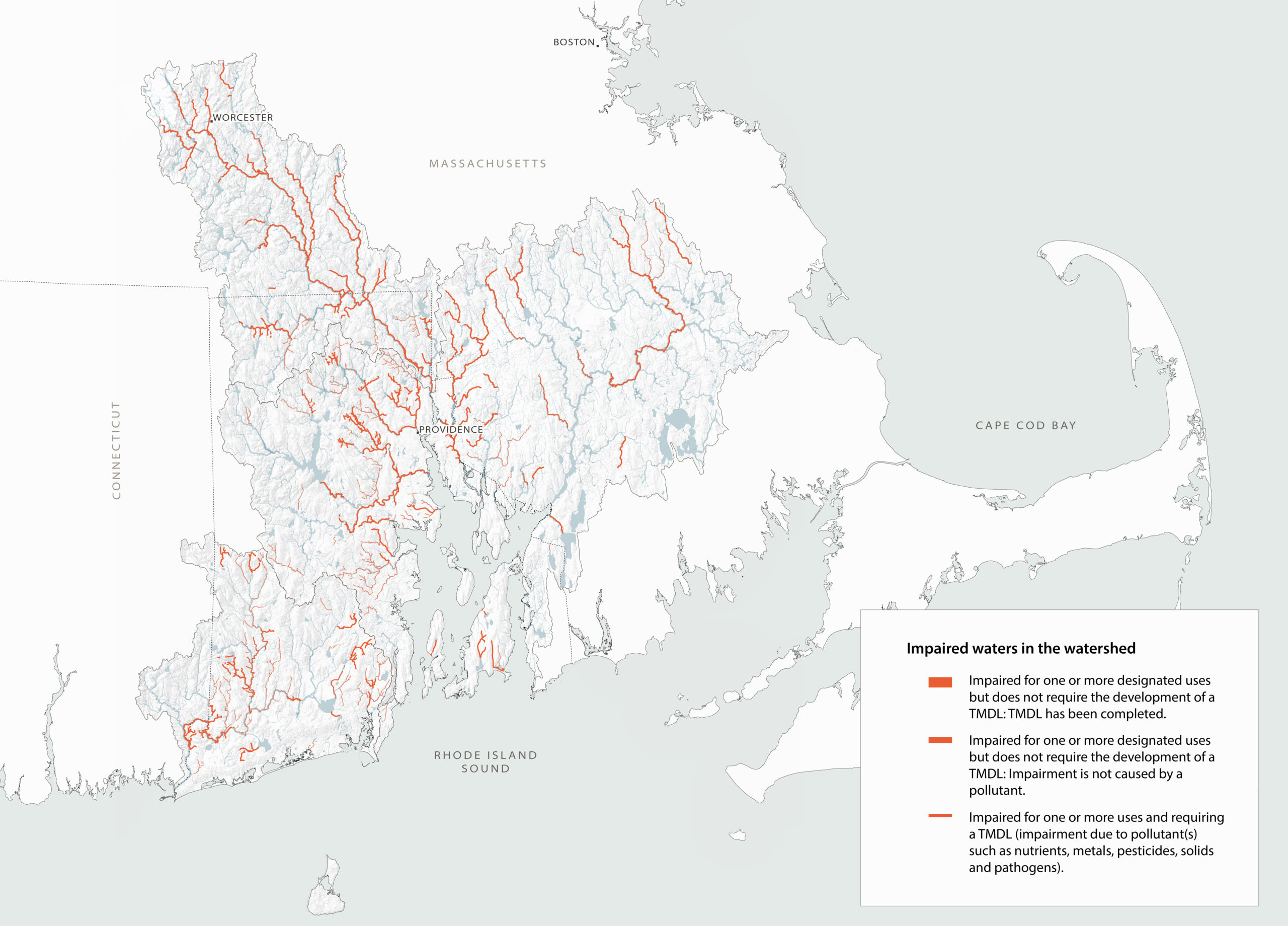
Map of impaired waters in the watershed. A dam in the middle of a forest may have a different level of attachment than one in the middle of town.
For more information about individual dams, please see the interactive map.
Excess nutrients (nitrogen-N and phosphorus-P) can create undesirable conditions in reservoirs and coastal waters. These high concentrations of nutrients can trigger the growth of aquatic plants and algae, which is likely to consume oxygen in the water column. At its worst, excess nutrients and low oxygen conditions can cause large scale fish kills within lakes and Narragansett Bay. Some blooms, like those produced by cyanobacteria, or blue-green algae, are especially worrisome as they are toxic to humans and animals.

Juvenile menhaden fish kill, Greenwich Bay RI August 20, 2003
Source: Tom Ardito, NBEP (ian.umces.edu/media-library)
In certain settings, scientists have hypothesized that a small portion of dams — those with reservoirs located within headwater tributaries — may actually promote natural removal processes or storage of nitrate and improve water quality in downstream estuaries. The riparian wetlands around the dam also may be protecting excess nutrients from entering rivers. Research is underway to determine if nutrient retention may be an unexpected tradeoff for dam removal.
Sediment
Rivers naturally transport sediment downstream; however, when dams are built, most sediments are trapped and settle behind the dam. There are two important concerns regarding sediment including accumulation and toxicity.
Accumulation: Unless the reservoir is dredged, sediment will accumulate over time. Generally, there will be more accumulated sediment in watersheds with more urban areas. Sediment accumulation reduces the reservoir water storage capacity, which can lead to flooding during high flow conditions and storms. Additionally, trapped sediment can cover the habitat of bottom-dwelling species. The accumulation of sediment behind a dam can cause the stream below the dam to be sediment starved often resulting in erosion.
Contamination: Since many dams within the Narragansett Bay and Coastal Watershed date back to the Industrial Revolution, a wide variety of pollutant materials, including nutrients, metals, hydrocarbons, and exotic organic compounds may be present in the sediments behind a dam. Dams may prevent contaminated sediment from traveling downstream and further dispersing these pollutants.
Sediment management is an important consideration when looking at scenarios for the future of a dam. Sediment behind a dam – contaminated or not – will often make dam removals more complex and costly. When a dam is removed, sediment may be released downstream, which increases turbidity, impacts downstream wetland habitats, and potentially, releases contaminants. There are three primary sediment management alternatives to consider if the decision is made to remove a dam: Sediment removal and disposal; allowing the sediment to flow downstream and get redistributed by the river; and capping, or in-situ remediation if the sediment is highly contaminated. The decision about how to manage the sediment will depend on a “due diligence” review to consider the current and past upstream land uses as well as contaminant screening if there is any likelihood of contamination.
In addition to depriving rivers of sediment, dams can also diminish sediment supplies in coastal ecosystems. Sediment from the rivers within the watershed help to nourish the beaches and salt marshes in Narragansett Bay. Salt marshes within Narragansett Bay are currently drowning due to sea level rise. Because dams prevent the flow of sediment downstream to the Bay, they effectively reduce the capacity of salt marshes to adapt to rising sea levels.
For more information see “Dam Removal and Wetland Regulations”
Cost + Funding
Dam removal, repairs and/or modifications can be costly, and because every dam is different there are many factors that can affect the cost and economic impact of a decision. Some economic factors to keep in mind when considering possible future dam scenarios include short-term cost, long-term cost, liability cost, and societal economic impacts.
Cost
When examining the cost of various scenarios, the short-term cost of the alternative is often the primary consideration. Short-term costs may span multiple phases, including: Public outreach and feasibility study; designing and permitting; implementation (repair, removal or modification); and post-removal monitoring. The actual cost of implementation will vary depending on the size, location, and condition of the dam.
It is also important to account for the long-term cost of dam maintenance and operation. Repairing or upgrading a dam may be less expensive than removal in the short-term, but the cost of repairing and maintaining a dam will be an ongoing expense.
In addition to the direct economic impact of any modifications to the dam, there may be other societal economic impacts to consider. For example, if a reservoir is a significant tourist attraction and the local economy is built around recreation, it will be important to consider the impact of various scenarios on local revenue. Furthermore, it will be critical to consider potential impacts to surrounding property values.
While many dam modification alternatives (e.g., Nature-like fishway, by-pass channel, etc.) can be more costly than repair or removal, they may allow for a community to find a compromise and balance the trade-offs on an otherwise controversial decision.
Funding
Dam projects often require a combination of different funding sources from state and federal agencies, non-profit organizations, cities, towns, and private foundations. In some cases, there may be a greater likelihood of external funding if full removal is chosen, but each case is particular and the economic considerations need to be evaluated alongside other dimensions of the dam decision. Any available grants and loans will be specific to the stated purpose of the dam removal. For example, there may not be grants available for restoration of fish passage, but there could be funds available for watershed restoration, flood mitigation, or coastal and climate resilience.
There are close to one hundred thousand documented dams in the United States, approximately 14,000 of which are in New England. Dams have shaped complex landscapes; they are a symbol of economic prosperity and cultural identity as well as a potential source of clean energy and recreation. However, many dams are over a century old and would pose significant risk to downstream communities if they were to fail. In addition, dams dramatically impact our freshwater and coastal ecosystems by preventing the passage of migratory fish and altering nutrient and sediment flows.
The study area for this Dam Atlas encompasses the Narragansett Bay Watershed and the coastal watersheds of Rhode Island. Within this study area, we have mapped and analyzed more than 1,000 dams. Approximately 53% of the dams are within the state of Rhode Island, 44% are in Massachusetts and 3% are in Connecticut. Each dam within the watershed is unique; they vary in size, age, flow, material, and use; they differ in the ecological impact they have on the watershed; and they each have a distinct relationship to the surrounding communities.
In this section of the website, we introduce key ecological, social, infrastructural, and economic factors that are important to consider for the management of dams at the individual and watershed scale.







